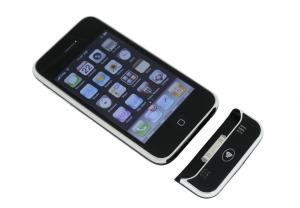Visa Likely to Endorse Second iPhone Attachment

Visa Inc. is likely to endorse another accessory that could turn Apple’s iPhone into a contactless-payment device and may be planning to have an exclusive agreement with the technology vendor, Wireless Dynamics Inc., NFC Times has learned.
The device, iCarte, announced last fall by the Canada-based technology company, offers full Near Field Communication functionality and embeds a secure chip that could store credit, debit or prepaid payment applications.
NFC Times saw a brief preliminary plan from Visa calling for trials of the iCarte with the card network’s payWave application starting in the late third quarter. It also mentioned “exclusivity” with iCarte. Visa declined to confirm the plan, however.
Visa has already locked in an exclusive deal with U.S.-based DeviceFidelity for that vendor’s contactless microSD cards to store payWave applications. The card network and DeviceFidelity last month further announced a special attachment for the iPhone, which could accommodate the microSD cards. The iPhone doesn’t have its own slot for the miniature flash-memory cards.
Banks plan to test the microSD, both in iPhones and in mobile phones with their own microSD card slots, during the second half of this year. Like the contactless microSD cards, iCarte would enable Visa’s main customers, banks, to introduce contactless-mobile payment on Apple's popular smartphone without having to wait for real NFC phones or deal directly with mobile operators.
Wireless Dynamics CEO Ambrose Tam told NFC Times last month he expected certification for the iCarte device from Apple as well as Visa and MasterCard by mid-June. It is unclear if the company has received any of the certifications. But this week, Tam said in an e-mail response that the "iCarte program is progressing well.” He was unavailable to answer specific questions. The company announced the iPhone attachment last November and has been waiting, in particular, for Apple's certification.
The device embeds a full NFC chip, which would enable users to tap their iPhones as they would contactless cards to pay for purchases at the point of sale or cover transit fares at subway gates or onboard buses. But iCarte also lets users read RFID tags and transfer data in peer-to-peer mode, just like NFC phones, said Tam. The tag reading, for example, could enable consumers to tap smart posters to download coupons or promotional videos. The attachment fits into the bottom dock of the iPhone.
The DeviceFidelity microSD card and other contactless microSDs headed for market do not support NFC reader or P2P modes, though DeviceFidelity is trying to build full NFC into its iPhone attachment.
Besides bank-issued payment applications, the embedded chip in the iCarte, from NXP Semiconductors, could support the popular Mifare transit application. NXP likely produces the NFC chip in the device, as well. “Also, the read range is superior to other NFC phones and accessories,” said Tam in an e-mail message.
That may be a reference to DeviceFidelity’s In2Pay microSD, which stole Wireless Dynamics’ thunder when it got the endorsement of Visa in February. There was even more buzz in May when plans emerged for the Visa-backed and Apple-certified iPhone attachment from DeviceFidelity. That attachment comes with its own antenna, extending the range for payment transactions to 4 centimeters, said DeviceFidelity chief operating officer Amitaabh Malhortra. Like iCarte, it fits into the bottom dock of the phone. Both DeviceFidelity and Wireless Dynamics are working on adapting their attachments for the new fourth-generation iPhone.
Malhortra emphasized that unlike iCarte, DeviceFidelity’s microSD can work in most phones that have microSD card slots, though the read range is shorter than for the iPhone, since the transaction is sent via a tiny antenna embedded in the cards, using an extra power boost from the phones.
“We’re not looking for solutions only for iPhones,” he told NFC Times. “We look for solutions across different platforms, and it includes iPhone." He added that putting payWave on a removable card enables consumers to take the application to other devices. “It’s really important that your financial credential could be portable,” he said.
An announcement from Wireless Dynamics on the availability of iCarte and possible partnership with Visa is likely soon.












